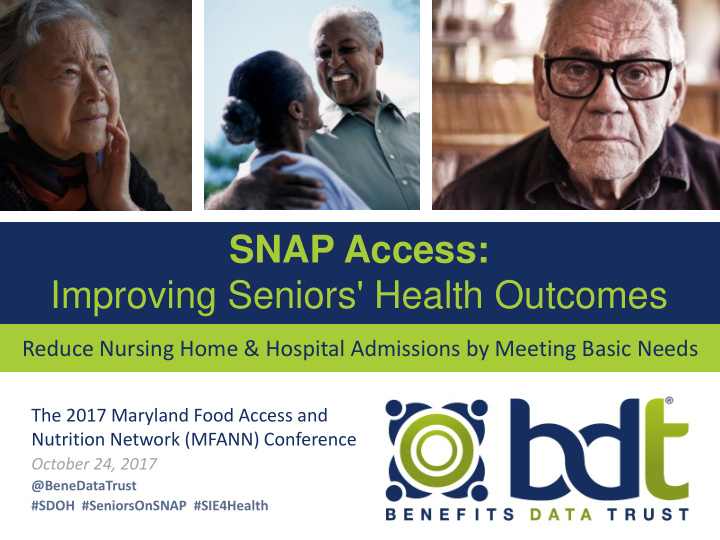



SNAP Access: Improving Seniors' Health Outcomes Reduce Nursing Home & Hospital Admissions by Meeting Basic Needs The 2017 Maryland Food Access and Nutrition Network (MFANN) Conference October 24, 2017 @BeneDataTrust #SDOH #SeniorsOnSNAP #SIE4Health
T ITLE • Text
SERVICE DELIVERY MODEL
I’m looking forward to help with the food and not having to worry about asking my children if they can help me… I really appreciate your help. -Ms. J, age 66 4
The Problem: Seniors Basic Needs Aren’t Met 88% of US healthcare expenditures are spent on medical care alone, but: • 10% is attributed to medical care • 70% is attributed to behavioral and socio-economic factors 5
The Research Collaboration Benefits Data Trust The Johns Hopkins School of Nursing The Hilltop Institute at UMBC Maryland Department of Human Services Maryland Department of Health Robert Wood Johnson Foundation ( Links to the original research : the first on hospitals and the second on nursing homes) 6
The Study Hypothesis Access to Supplemental Nutrition Assistance Program (SNAP) food assistance Improved health outcomes and reduces healthcare costs 7
The Study Population • 68,956 dual-eligible Unknown 10% adults 65+ • Nearly 70% female African Other • At least 2 chronic American 13% 33% conditions Hispanic 5% Caucasian 39% 8
Deep Poverty Average annual income approximately $5,800 9
10
The Findings: Seniors on SNAP After just one year… Odds of nursing home admission: -23% Odds of hospital admission : -14% Shorter stays in both settings if admitted 11
Benefits Utilization • 47% SNAP enrollment • Average monthly benefit of $117 21% LIHEAP enrollment • • Average annual benefit of $339 12
What We Can Save If all non-SNAP participants from sample were enrolled: • $34 million savings from nursing homes • $19 million savings from hospitalizations 13
Research Implications for Low-Income Seniors • Over 5.5 million eligible low-income seniors not enrolled in SNAP • Seniors average SNAP He went above and beyond the call. I’m an old man, and I don’t amount: $1,400 / year understand half of these things . Every question I asked him, he gave me a good answer in a language I can understand . He did a 14 wonderful, wonderful job. -Mr. M, age 71
When you're 77, it's hard to understand some of these things. You have been such a help today! I didn't even know they had these [benefits!] You don't know how great that is when you're living on Social Security.” -Ms. R, age 77 15
Comprehensive Solutions 16
17
Connect with Us! Katherine Heflin, MS Email: Program Manager kheflin@bdtrust.org Maryland Benefits Center at Twitter: Benefits Data Trust @BeneDataTrust @KatherineHeflin LinkedIn: BDT: https://www.linkedin.com/co mpany/1855250/ Katherine: https://www.linkedin.com/in /katherine-heflin-15662731/ 18
Citations Our New Studies Cited: • Samuels, L. et al. “Does the Supplemental Nutrition Assistance Program Affect Hospital Utilization Among Older Adults? The Case of Maryland.” Population Health Management . http://online.liebertpub.com/doi/pdfplus/10.1089/pop.2017.0055 • Szanton, et al. “Food assistance is associated with decreased nursing home admissions for Maryland’s dually eligible older adults.” BMC Geriatrics. http://bmcgeriatr.biomedcentral.com/articles/10.1186/s12877-017-0553-x Other Sources Cited: • Bengle, Rebecca, et al. “Food Insecurity is associated with Cost -Related Medication Non-Adherence in Community-Dwelling, Low- Income Older Adults in Georgia,” Journal of Nutrition for the Elderly , 29.2 (2010): 170-191. • Berkowitz, Seth, et al. “Food Insecurity and Metabolic Control among U.S. Adults with Diabetes, “ Diabetes Care , 36.10 (2013): 3093-3099. • Bradley, E., et al., (2011). Health and Social Services Expenditures: Associations with Health Outcomes , BMJ Quality & Safety. 20(10), 826-831. • Bradley, E., et al (2016). Variation in Health Outcomes: The Role of Spending on Social Services, Public Health, and Health Care, 2000-09 , Health Affairs 35(5), 760-768. • Health Impact Project, “Case Study: Low Income Energy Assistance Program,” Accessed at http://www.healthimpactproject.org/resources/case-study-low-income-energy-assistance-program • Robert Wood Johnson Foundation, “Health Care’s Blind Side: The Overlooked Connection between Social Needs and Good Health,” December 2011. Accessed at http://www.rwjf.org/content/dam/farm/reports/surveys_and_polls/2011/rwjf71795 • Sokol, Michael, et al. “Impact of Medication Adherence on Hospitalization Risk and Healthcare Cost,” Medical Care, 43.6 (2005): 521-530. • Seligman, Hilary K, et al. “Food Insecurity is associated with Chronic Disease among Low - Income NHANES Participants,” Journal of Nutrition, 140.2 (2010): 304-310. 19
Recommend
More recommend